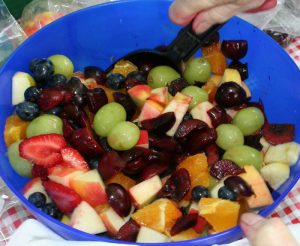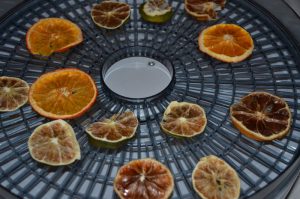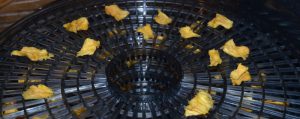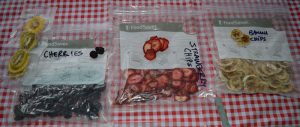Back-country camping doesn’t mean putting yourself at risk of getting Scurvy. OK no one is at risk of that, but fresh fruit on a canoe trip is such a treat. On short trips apples, oranges and grapefruit travel well.
On long trips fresh fruit isn’t really an option because it’s heavy, it takes up a lot of space and it’s easily damaged. On long trips taking your own dehydrated fruit is the best option. We dehydrate fruit when it is in season, vacuum seal it in resealable bags and store it in the freezer until we go camping. Well we try, it doesn’t always last.
Fresh Fruit

I often make a fruit salad to take on a short trip. A few tips:
- Make the fruit salad the night before your trip – it is a great way to use up things in your fridge
- Cut the fruit, mix it all together and add some maple syrup (the most delicious preservative you will ever find)
- Lightly vacuum seal the fruit salad (you don’t want to draw the juice into the seal)
- Wrap the vacuum sealed fruit in newspaper and place it in a Ziplock (this protects your barrel from potential leaks and lets you reseal the fruit. Note: If you don’t have a vacuum sealer, use two freezer Ziplock bags
- Put the fruit in the fridge overnight so it’s cold when you pack it. It should keep for two days – two mornings with fresh fruit salad – what a treat
- Note: For an extra special breakfast, pack the pre-made, individually wrapped Belgian Waffles, and cover them with the fruit – yummy
- If you have a cooler, take some yogurt to add into the mix
Dehydrated Fruit
To prepare fruit for the dehydrator, wash it really well. Cut it into small pieces or thin slices and place it in the dehydrator. Vacuum seal and freeze until your trip. You will read all kinds of recommendations about washing and drying your cut fruit, but I prefer to keep all the juices in the fruit. You can also add things to keep it from discolouring, but really why bother, darkened pineapple will taste just the same as bright yellow pineapple.
Through the year, we always have fruit we can’t use quick enough so we will get out the dehydrator – no waste and great to have the fruit on trips.
Fruit is usually dried at 60 degrees Celsius or 140 degrees Fahrenheit for 8+ hours.
Oranges, Lemons and Limes

Fresh citrus is definitely too heavy to carry on long trips. However, I know people who fish are always willing to make the sacrifice for a lemon.
Taking dehydrated citrus is a nice treat. Place a piece of dehydrated orange, lemon or lime in your water bottle in the morning. One slice is enough to add some flavour to your water for a day. This is especially nice if the lake water isn’t tasty.
Note: When it is time to brush your teeth, get fresh water; there is nothing worse than brushing with citrus water – something we learned the hard way.
Slice the citrus thinly (rind on) and set the temperature to 60 degrees Celsius or 140 degrees Fahrenheit for 8+ hours.
Strawberries: I canoe with several people who would say that strawberry chips on cereal is the best thing ever. They are pretty good, but I have a hard time not eating the fresh berries. Although, the Ontario strawberry season is very short, so dehydrating is a great way to be able to enjoy them all summer.
For strawberry chips, cut them in to thin slices. You can quarter them if you prefer larger pieces.
Set the temperature to 60 degrees Celsius or 140 degrees Fahrenheit for 8+ hours.

Pineapple: My favorite dehydrated fruit! I just cut up the pineapple and put it on the dehydrator trays. I cut the pineapple into pieces about the size of a quarter. It really is more like candy than fruit. I need to keep myself out of the freezer when we have pineapple.
Set the temperature to 60 degrees Celsius or 140 degrees Fahrenheit for 8+ hours.
Bananas: I know someone who thinks banana chips are the best. They dehydrate them for a very, very long time so they are really crispy. They then break them up into small pieces and stir them into both hot and cold cereal.
Cut the banana into thin slices and set the temperature to 60 degrees Celsius or 140 degrees Fahrenheit for 10 days. OK not10 days but perhaps a day or two to get that crunch.

Kiwi: Not my favorite. I think our Kiwi was perhaps not ripe enough and the end result was something less than sweet. However, we camp with people who love them.
Slice thinly and set the temperature to 60 degrees Celsius or 140 degrees Fahrenheit for 8+ hours
Cherries: You need to pit and cut the cherries. Don’t be surprised if your kitchen looks like a crime scene when you are done; definitely don’t wear your favorite shirt. However, it’s worth the effort because they are very yummy dehydrated.
After you remove the pit and cut the cherry in half, set the temperature to 60 degrees Celsius or 140 degrees Fahrenheit for 8+ hours.
Blueberries: I cannot bring myself to dehydrate wild blueberries. They take forever to pick (and cost a fortune to buy) so I just sit down and eat them fresh. If you are lucky, you will find wild blueberries in your travels anyway. We have a couple favorite places to pick – but unfortunately I can’t give you those details.
I did dehydrate cultivated blueberries once but I was not happy with the results. Nothing beats the flavour of wild blueberries.

